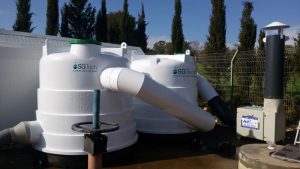Ozone/Carbon Odor Control on Wastewater Facility– Description/Cost Comparison/Test Results

Highlights
- 86% to 95% odor reduction at stack outlet (EN13725 testing protocol)
- Significant capital/maintenance cost reductions
- Maintenance vs. biofilters or scrubbers significantly reduced
- Operating costs lower than biofilters or chemical scrubbers
- 84% H2S reduction
GENERAL
Results of an Envron wastewater odor control installation using a combination of Ozone as the initial oxidizer with a carbon scrubber to destroy any excess ozone prior to release to atmosphere. The system was installed in the summer of 2014. Independent testing shows 86 to 95% odor reduction at the stack outlet. (EN13725 testing protocol)
OZONE
Ozone is the fastest acting oxidizer that is commercially available. Ozone systems provide consistent oxidizer output for rapid destruction of long-chain organic (odorous) compounds. The Ozone system at this facility provides oxidation of odors and the carbon system is used to remove any excess Ozone in the airstream (required by EN13725 testing protocol). If the regulatory requirements did not require EN13725 at this site, the carbon scrubbing would not be required. Static mixers in the system ensure entrainment of the ozone with the odorous compounds.
CARBON
A carbon bed provides “scrubbing” of the Ozone/gas mix to ensure compliance with the EN13725 protocol. Since the slight residual Ozone at the stack outlet would be picked up in the tests, the carbon is used to destroy any residual Ozone at the stack outlet for the testing protocol.
This also means that higher initial dosages of ozone can be designed into the system for a more thorough and rapid destruction of long-chain (odorous) compounds. This is also beneficial for fluctuating odor levels.
OZONE ADVANTAGES vs. SCRUBBERS and BIOFILTERS
Contacting/Retention times are reduced with Ozone and system footprints are much smaller than biofilters or scrubbers. This makes the system ideal for applications where space for the contacting/retention system is tight or limited. Traditional chemical based scrubbers can be replaced with Ozone thereby eliminating water disposal issues.
Envron Ozone generating systems are usually distributed (depending on site requirements) meaning that routine maintenance on a single generator/oxygen concentrator can be performed while the rest of the system is running. In the unlikely event of a single generator/concentrator failure, the rest of the system remains running, providing 24/7 uptime.
Routine maintenance for both the carbon scrubber and Ozone system can be scheduled providing adequate lead time for personnel deployment.
OZONE/CARBON vs BIOFILTERS
Ozone/carbon offers a much smaller footprint than traditional biofilters. On a retrofit contacting/retention systems can be roof-mounted or on the ground. Alternately, the existing building ventilation system can be enlarged. With new construction, the contacting/retention system can be built into the building ventilation system. Because any excess ozone is being removed by the carbon, Ozone generation can be increased allowing more ozone to be available for fluctuating odor levels.
Biofilters require a precise operating environment (temperature, moisture) to remain effective. In the case of weather fluctuations, a biofilter’s effectiveness may be compromised and the biofilter may have to “recover” by rebuilding the biofilm. Ozone/Carbon systems are mechanical and do not require a “break-in” or “recovery” period.
COST COMPARISON
Capital Cost
| Ozone/Carbon | $ |
| Biofilter | $$$ |
| Thermal Oxidizer | $$$$$$ |
Operating Cost
| Ozone/Carbon | $ |
| Biofilter | $$ |
| Thermal Oxidizer | $$$$ |
Maintenance Cost
| Ozone/Carbon | $ |
| Biofilter | $$ |
| Thermal Oxidizer | $$$ |
Sewage Pump Station –Test Results
Wastewater flow: 400 m3/day – Please note – systems can be scaled up or down depending on site requirements.
Sewage type: sanitary
Flow Type: gravitational
Chimney gas flow: 1,100 M3/hr (650 CFM) – Please note systems are scalable. Envron systems have been sized to 150,000 M3/hr (88,000 CFM)
Facility Description
- Self-contained Oxygen Concentrator provides 95% pure oxygen to the ozone generator
- Envron ozone generator provides Ozone to the contacting/retention system.
- 21ZX control sensor, the sensor measures ozone concentrations in the range of 10/0.01 ppm, and will be calibrated annually.
- Contacting/Retention provided by HDPE Rotomold tanks.
- Carbon Scrubber – 3 second Empty Bed
Odor Abatement
Odor sampling was done by an accredited laboratory according to European standard- EN13725.
Sample 1 (low odors)
No. of units odor treatment facility entrance: 8661 odor units / cubic meter of air
No. of units odor treatment facility exit 455 odor units / cubic meter of air.
Percent reduction: 95%
Sample 2 (peak odors)
No. of units odor treatment facility entrance: 46,400 odor units / cubic meter of air
No. of units odor treatment facility exit: 6,500 odor units / cubic meter of air.
Percent reduction: 86%
Hydrogen sulfide
The concentration of hydrogen sulfide treatment facility entrance: 6 mg / m³ air
The concentration of hydrogen sulfide treatment facility exit: 0.962 mg / m³ air
Percent reduction: 84%
